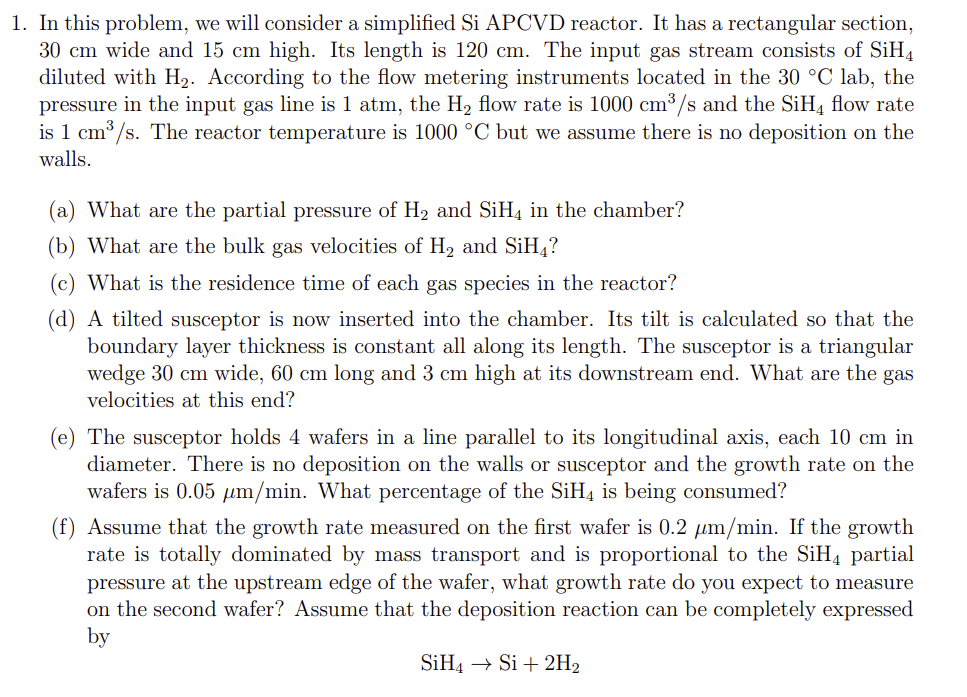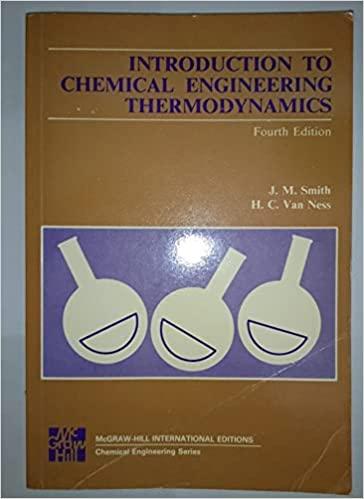Answered step by step
Verified Expert Solution
Question
1 Approved Answer
In this problem, we will consider a simplified Si APCVD reactor. It has a rectangular section, 30cm wide and 15cm high. Its length is 120cm.
 In this problem, we will consider a simplified Si APCVD reactor. It has a rectangular section, 30cm wide and 15cm high. Its length is 120cm. The input gas stream consists of SiH4 diluted with H2. According to the flow metering instruments located in the 30C lab, the pressure in the input gas line is 1atm, the H2 flow rate is 1000cm3/s and the SiH4 flow rate is 1cm3/s. The reactor temperature is 1000C but we assume there is no deposition on the walls. (a) What are the partial pressure of H2 and SiH4 in the chamber? (b) What are the bulk gas velocities of H2 and SiH4 ? (c) What is the residence time of each gas species in the reactor? (d) A tilted susceptor is now inserted into the chamber. Its tilt is calculated so that the boundary layer thickness is constant all along its length. The susceptor is a triangular wedge 30cm wide, 60cm long and 3cm high at its downstream end. What are the gas velocities at this end? (e) The susceptor holds 4 wafers in a line parallel to its longitudinal axis, each 10cm in diameter. There is no deposition on the walls or susceptor and the growth rate on the wafers is 0.05m/min. What percentage of the SiH4 is being consumed? (f) Assume that the growth rate measured on the first wafer is 0.2m/min. If the growth rate is totally dominated by mass transport and is proportional to the SiH4 partial pressure at the upstream edge of the wafer, what growth rate do you expect to measure on the second wafer? Assume that the deposition reaction can be completely expressed by SiH4Si+2H2
In this problem, we will consider a simplified Si APCVD reactor. It has a rectangular section, 30cm wide and 15cm high. Its length is 120cm. The input gas stream consists of SiH4 diluted with H2. According to the flow metering instruments located in the 30C lab, the pressure in the input gas line is 1atm, the H2 flow rate is 1000cm3/s and the SiH4 flow rate is 1cm3/s. The reactor temperature is 1000C but we assume there is no deposition on the walls. (a) What are the partial pressure of H2 and SiH4 in the chamber? (b) What are the bulk gas velocities of H2 and SiH4 ? (c) What is the residence time of each gas species in the reactor? (d) A tilted susceptor is now inserted into the chamber. Its tilt is calculated so that the boundary layer thickness is constant all along its length. The susceptor is a triangular wedge 30cm wide, 60cm long and 3cm high at its downstream end. What are the gas velocities at this end? (e) The susceptor holds 4 wafers in a line parallel to its longitudinal axis, each 10cm in diameter. There is no deposition on the walls or susceptor and the growth rate on the wafers is 0.05m/min. What percentage of the SiH4 is being consumed? (f) Assume that the growth rate measured on the first wafer is 0.2m/min. If the growth rate is totally dominated by mass transport and is proportional to the SiH4 partial pressure at the upstream edge of the wafer, what growth rate do you expect to measure on the second wafer? Assume that the deposition reaction can be completely expressed by SiH4Si+2H2 Step by Step Solution
There are 3 Steps involved in it
Step: 1

Get Instant Access to Expert-Tailored Solutions
See step-by-step solutions with expert insights and AI powered tools for academic success
Step: 2

Step: 3

Ace Your Homework with AI
Get the answers you need in no time with our AI-driven, step-by-step assistance
Get Started


